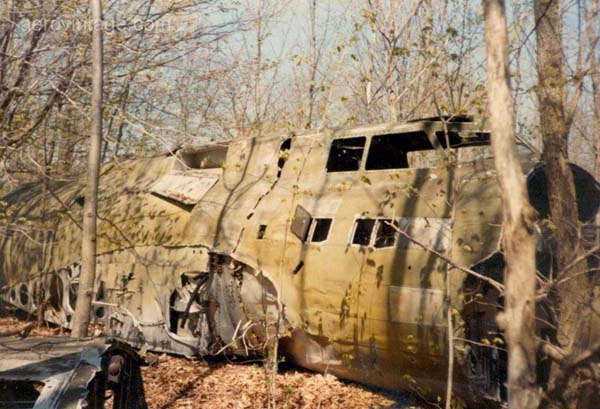 |
September 1985
The forward fuselage section as located in the field near Dow Field at Bangor, Maine. Mike Kellner was able to purchase the B-17 components for a reported $7,250 in 1985. A forest of trees had advanced to surround the airframe parts in the years since the late 1940s. (Mike Kellner via Bill Stanczak)
|
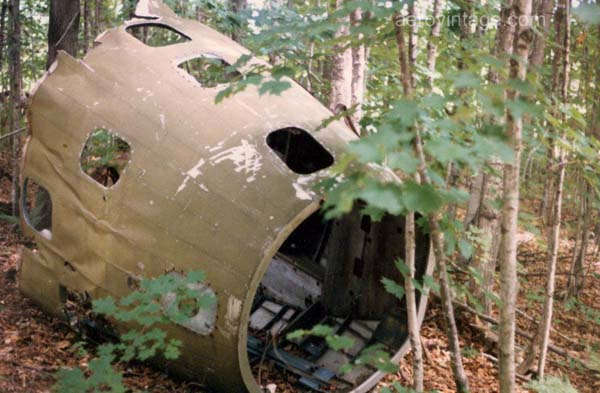 |
September 1985
Attempts were made to scrap the B-17 back in the late 1940s by the owner of junk yard. The nose section was sawn off and lay near the rest of the fuselage. Also in the area were the scrapped parts of a C-47, B-25D, and O-47, parts of which were also recovered. (Mike Kellner via Bill Stanczak)
|
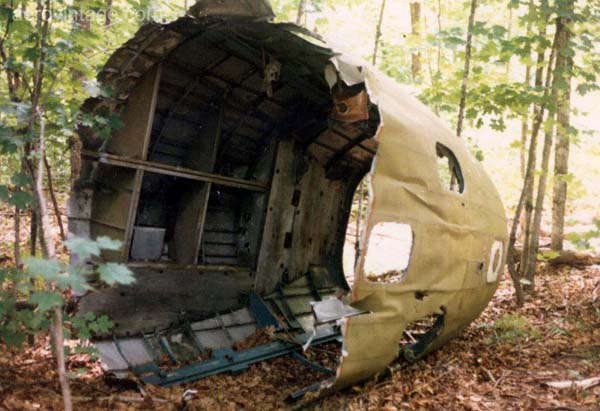 |
September 1985
Another view of the nose section, now seen from the rear. The floor of the nose compartment of the XC-108A, normally covered by plywood, has been largely removed. (Mike Kellner via Bill Stanczak)
|
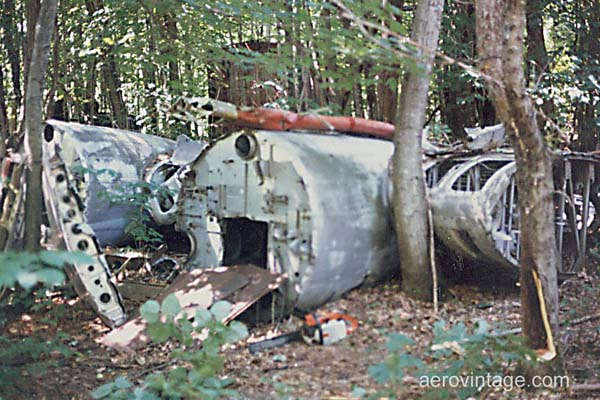 |
September 1985
The wing sections, deep in the forest, are nearly hidden. Engines, propellers, and cowlings are long gone. (Mike Kellner via Bill Stanczak)
|
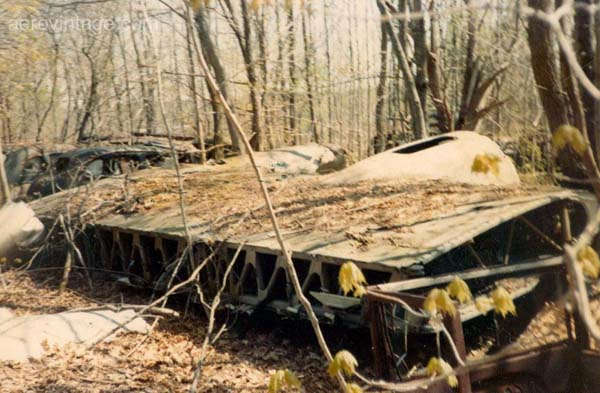 |
September 1985
Another view of a wing section, this appearing to be the right inner section. The trailing edge aft of the rear spar has been removed. (Mike Kellner via Bill Stanczak)
|
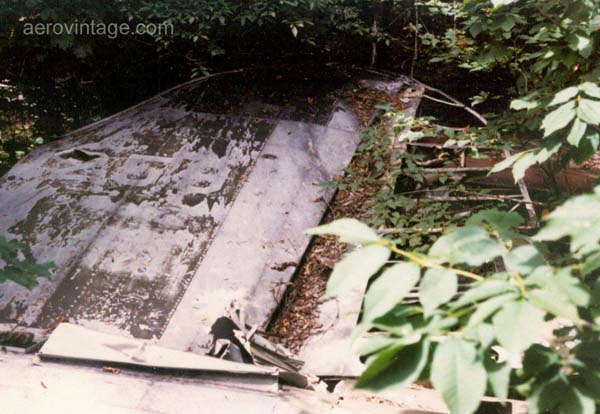 |
1992
The vertical stabilizer and rudder lying on their side on the forest floor. The remnants of the AAF serial, "12595," are visible on the tail section. Most of the parts were with the airplane, but much of the remains were badly damaged. (Mike Kellner via Bill Stanczak)
|
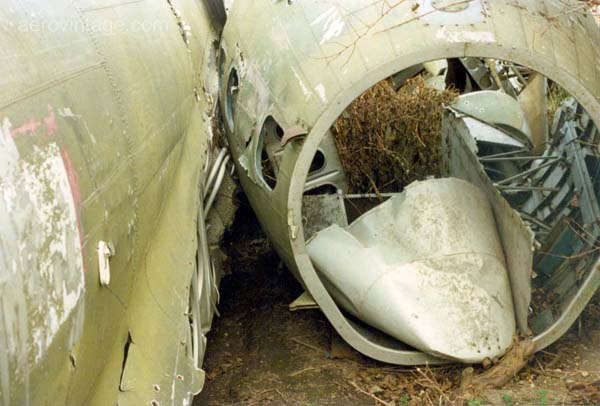 |
Sepember 1985
Preparation work underway to recover the parts. The nose section has been moved in close to the fuselage and parts stacked. Note the last vestiges of the red marking that surrounded the national insignia for several months in 1943. Note also on the side of the nose section the hinge mounts where the solid nose piece was attached. (Mike Kellner via Bill Stanczak)
|
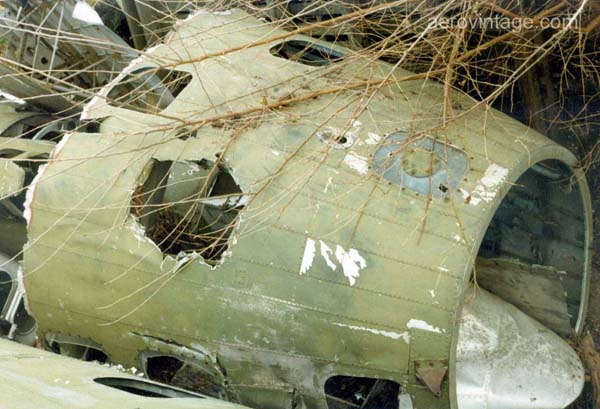 |
September 1985
A top view of the nose section. Even the smaller components have suffered major damage at the hands of the prior owner and the elements. (Mike Kellner via Bill Stanczak)
|
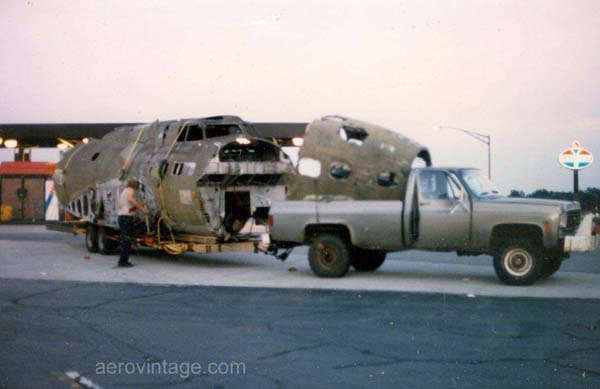 |
September 1985
It's not easy to move a B-17, or even an XC-108A. Here, Mike has the fuselage section on a large flatbed and the nose section is in the back of the pickup truck. Mike and Ken Kellner, and Don Fernstrom, moved this load. It must have elicited more than a few stares as during the move to Galt, Illinois, for the first part of the restoration. (Mike Kellner via Bill Stanczak)
|
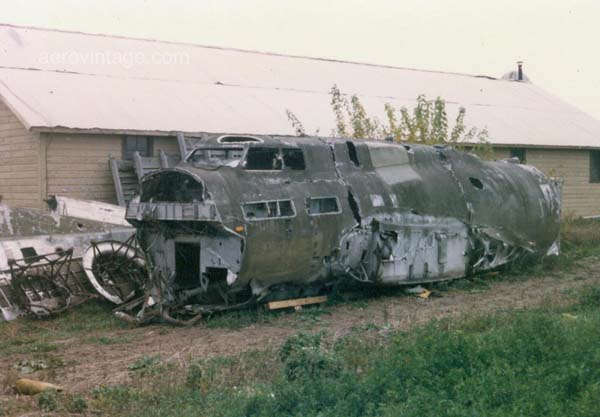 |
September 1985
The airframe was safely back at Galt, Illinois, with all but this fuselage section stored indoors. It would take several more years before serious work could start on the airplane. In 1995, it was moved to its present location at Marengo, Illinois. (Mike Kellner via Bill Stanczak)
|
 |
1999
The right inner wing section in outdoor storage circa 1999. The engines and cowlings were missing from the B-17E at recovery from Maine. (Dave Welch)
|
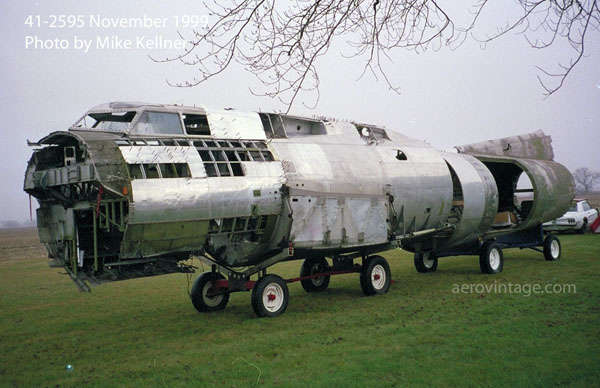 |
November 1999
The fuselage sections all lined up in November 1999. The extent of the required work is quite evident. The left side fuselage cargo door is still in place at this point. Most of the initial work on the project was confined to these two sections in an effort to reassemble the fuselage and repair the significant structural damage done when the attempt was made to scrap the airplane. (Mike Kellner)
|
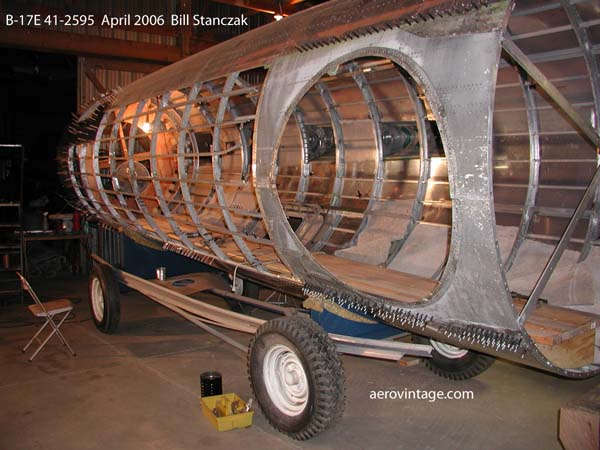 |
April 2006 The aft fuselage positioned on its side to ease the effort in the area being worked on. The circular cutout is the ball turret opening. Much structural repair has been done to the aft fuselage, including the removal of a large cargo door installed by Boeing in 1942 as this airplane was modified to become the XC-108A for the AAF. A great deal of effort has been done by owner Mike Kellner and his team to ensure that the correct extrusions, properly manufactured and heat treated, were used to make the repairs. This effort is hidden and won't be seen in the final product but it is being done right and to fully airworthy standards. There is much new structure, all manufactured according to the original Boeing blueprints, that is going into this airplane. (Bill Stanczak) |
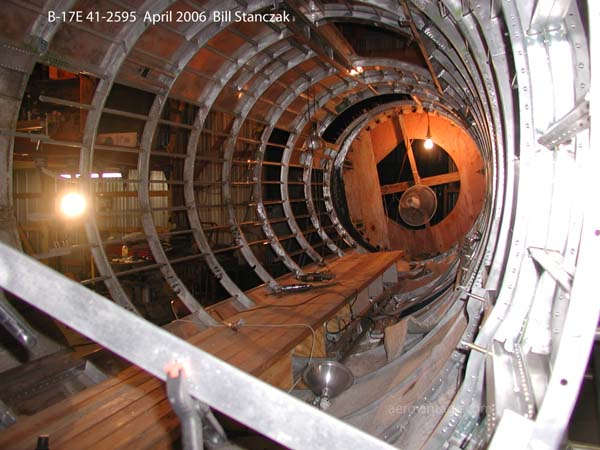 |
April 2006 Another photo of the same section of fuselage, now looking aft from the inside with the right waist gun position at the top and the fuselage floor on the left of the photo. This shows the complexity of the restoration effort. It's not just a matter of riveting in some new off-the-shelf pieces of aluminum ribs and moving on. Care has to be taken to keep the structure straight and true as repairs are made, and the proper materials must be used to ensure structural soundness and an accurate restoration. (Bill Stanczak) |
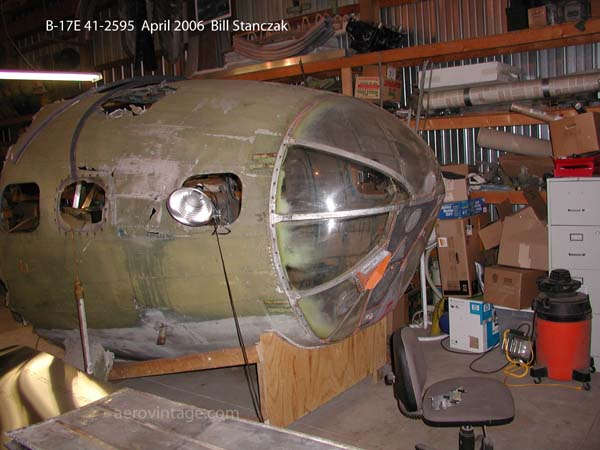 |
April 2006 The nose section is still detached from the main section of the fuselage, but standing by for rebuild and reattachment. Again, new structure to tie the main fuselage to the nose section is required, all done to the original Boeing drawings. Of interest here is the rare early-style nose piece of the B-17E and earlier versions. The nose piece come from parts unknown, at least to me, but Bill notes that it came to the Desert Rat project painted orange. Using oven cleaner, the orange paint was stripped away and now the framed nose has been fitted in place, at least temporarily. (Bill Stanczak)
|
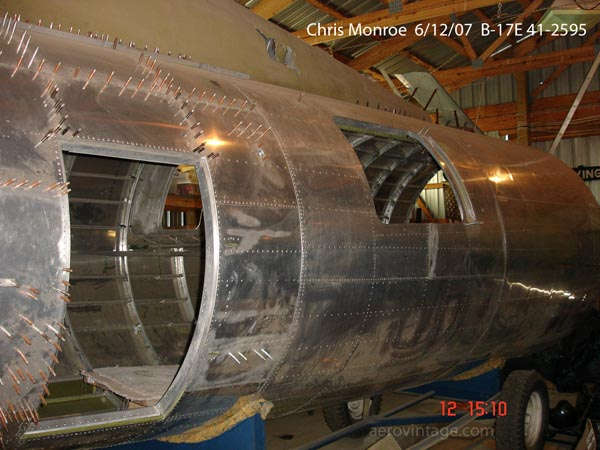 |
June 12, 2007
The right waist section after it was reskinned.
|
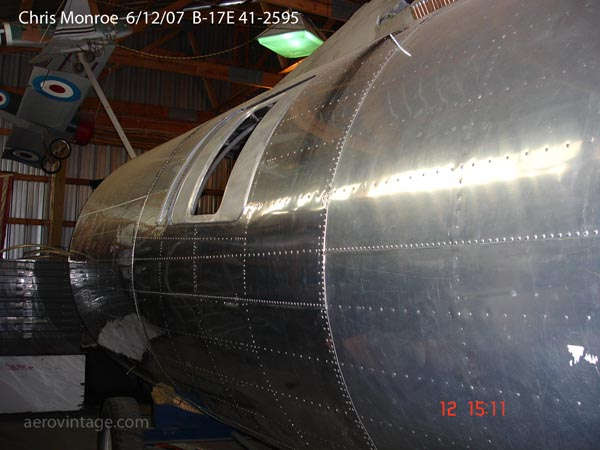 |
June 12, 2007
The left waist area pretty well completed. This is the section that housed the cargo door for the XC-108A. As can be seen, a lot of work has gone into bringing this area back to stock B-17E condition.
|
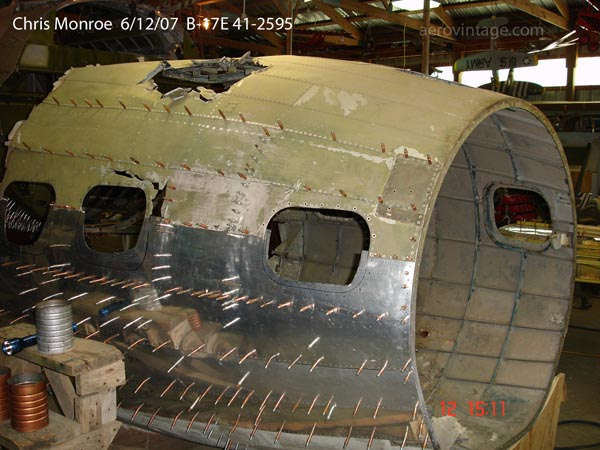 |
June 12, 2007
The nose section with a few new skins being attached. The nose is being prepared for reattachment.
|
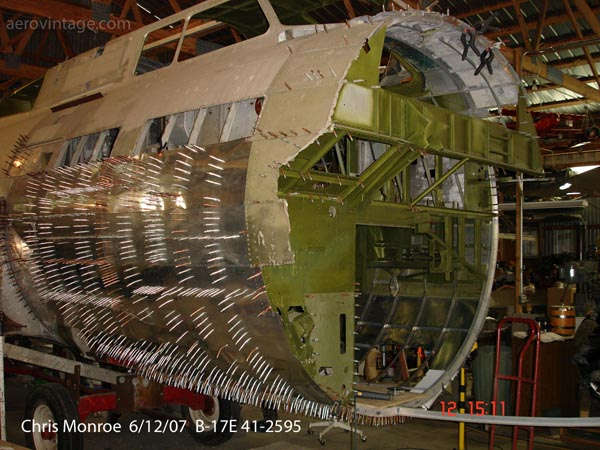 |
June 12, 2007
A photo of the right side of the cockpit section. This photo indicates the amount of reskinning being done, but doesn't show the underlying structural work that has also been required.
|
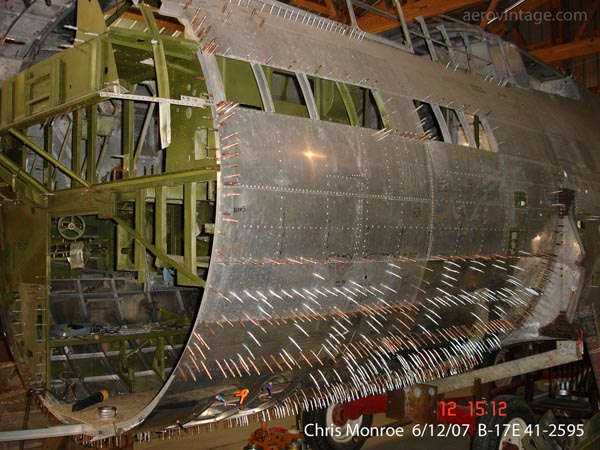 |
June 12, 2007
The left side of the nose in June 2007. This photo shows new skin being placed. As can be seen, the cockpit/nose section has been the main focus of this part of the restoration, in preparation of reattaching the nose section severed over a half century ago.
|
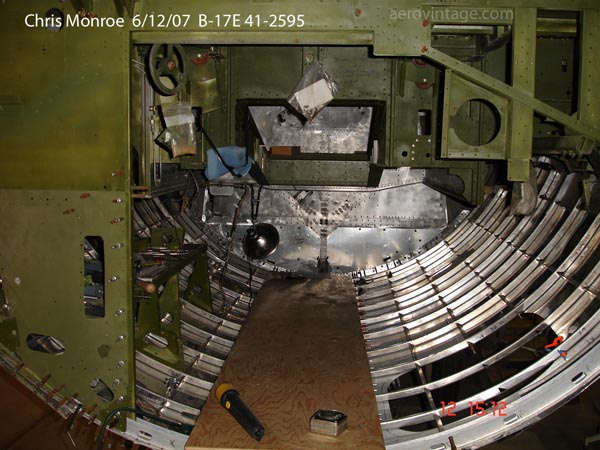 |
June 12, 2007
The interior of the lower forward fuselage looking aft. A close look at this photo shows the extensive structural work required to repair the crushed lower part of this area of the fuselage. Note how the forward entrance hatch, on the lower right of the photo, has ribs and longerons extending through the opening. Presumably, these will be removed and framed with a structural piece for the hatch opening.
|
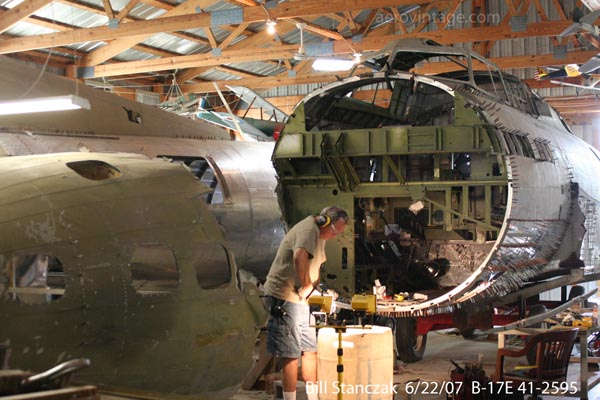 |
June 22, 2007
Big day at hand: reattaching the nose to the forward fuselage. The nose had been sawn off in the late 1940s when an attempt was made to scrap the airplane. It's probably a major psychological step to get the nose back on after so many years. With that step, the major components of the fuselage will be at least structurally complete. Pretty close to finsihing. Just the control system, electrical system, hydraulic system, fuel system, wings, horizontals and vertical stabilizers, control surfaces, wings, engines, propellers, landing gear, and a few other odd jobs. Ooops. Don't think about it. Just one step at a time.
|
 |
June 22, 2007
To quote Bill Stanczak, who was there for the event:
"Mike and Chuck and the guys spent all weekend getting this thing done. I was out Friday, and we got the nose in position, and strapped it on.
Saturday, we had Lucas, Greg, Dean, Jerry, and two other guys out, and we put a wooden carriage under it (in case it wanted to move).
Then, we spent time putting more substantial straps on the nose stringers to help bring it together and keep it stabilized."
|
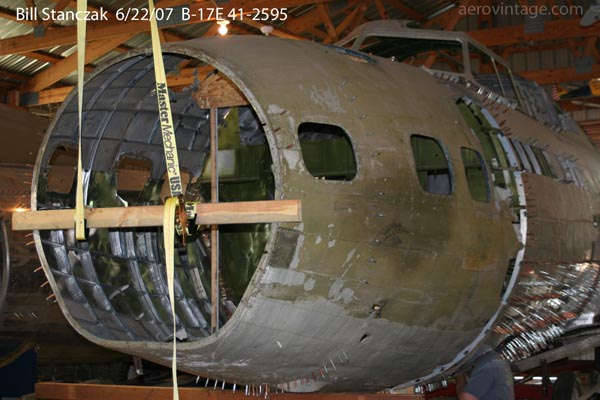 |
June 22, 2007
Bill Stanczak: "Today, Mike and Chuck worked to make sure it was properly aligned. Mike reported to me that the nose is within .1 degrees of level, and
aligned to within 1/16". Just utterly amazing! Next task is to replace the upper longerons. The co-pilot's side is full of inter granular corrosion, and needs a total replacement. The pilot's side has been repaired in a few places, but I think Mike will replace the whole thing, especially since we have some extra longerons now."
|
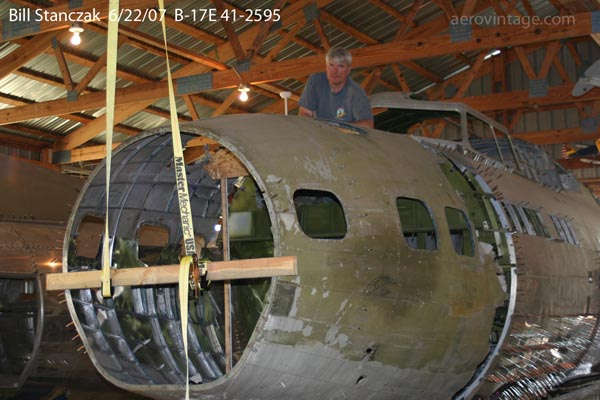 |
June 22, 2007
Bill Stancak: "The smile on Mike's face had to be seen to be believed. He already had visitors out today to look at the nose! News travels fast, I guess."
(Well, yeah, you read it here, right?)
|
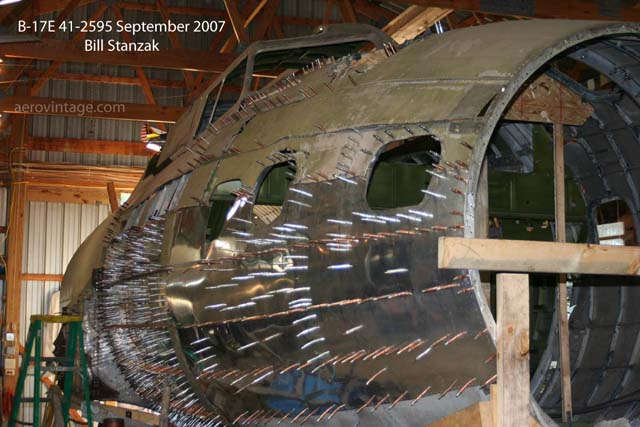 |
September 2007
View of the nose section being reskinned and repaired. (Photo by Bill Stanczak)
|
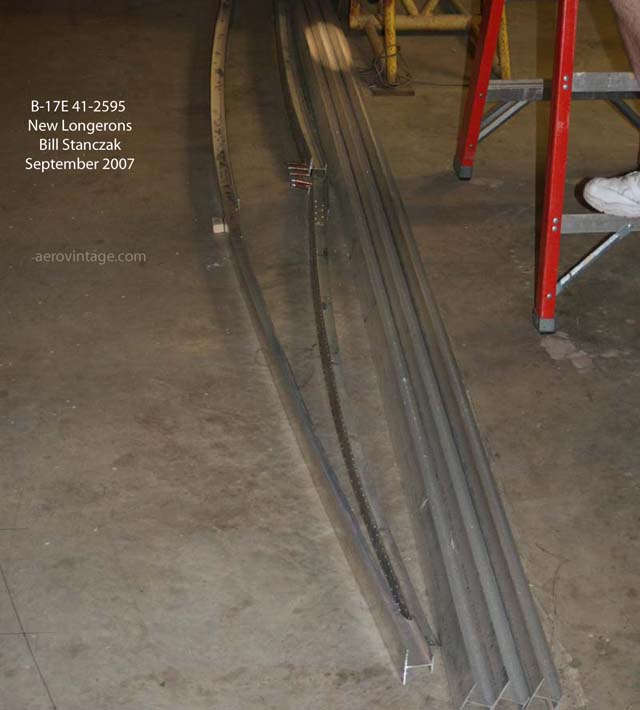 |
September 2007
View of the new longerons that have been manufactured for the nose section structure. (Photo by Bill Stanczak)
|
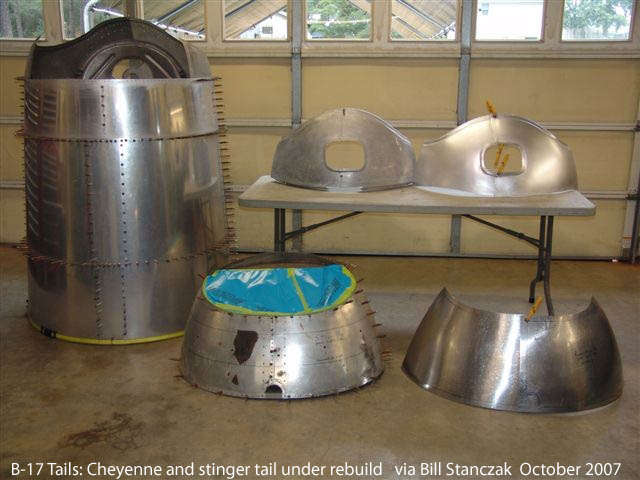 |
September 2007
Two tail gunner compartments under construction under the direction of Tom Wilson, combining both new build and old parts. A "tail stinger" compartment will be added to the Desert Rat project.
|
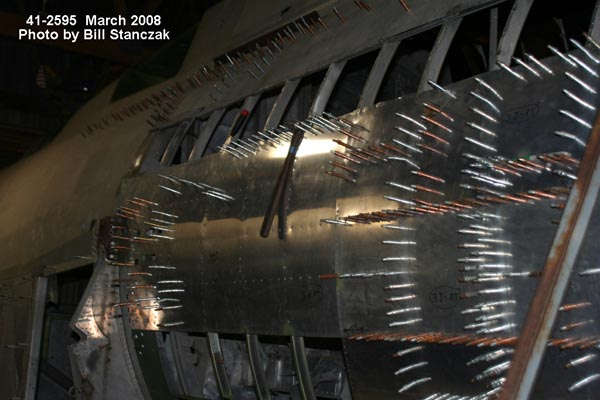 |
March 2008
"There has been some fitting of new bulb angle and ribs in the nose, and riveting done on the nose skins." (Photo by Bill Stanczak)
|
 |
March 2008
Work continues on the nose window frames in Georgia. Bill notes "We're about to pull the trigger on the wing carry through spars, a project that was on, off, on, off, and on again over the last 18 months. But, some operators are realizing that having new carry through spars on the shelf offer a good measure of insurance." (Photo by Bill Stanczak)
|
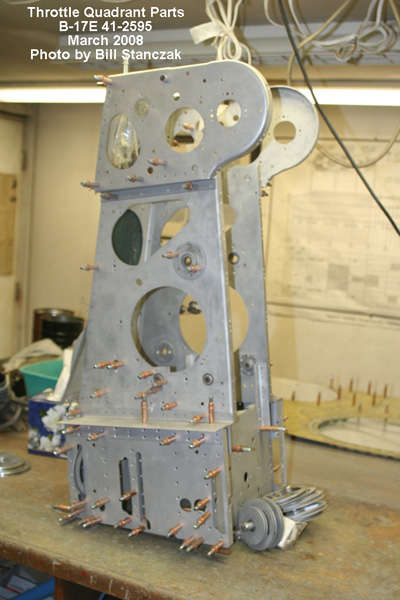 |
March 2008
We have also been working on our throttle quad, making some new aluminum pulleys and panels. (Photo by Bill Stanczak)
|
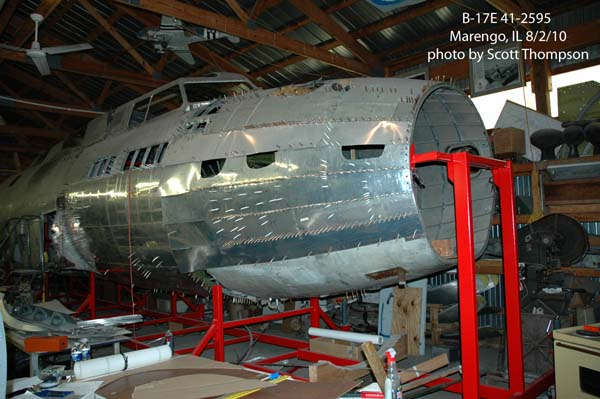
|
September 2010
The forward fuselage under gradual rebuild. Because the nose was chopped off, it needs to be structurally reattached. This has been a slow process as efforts have been diverted elsewhere. However, Mike Kellner notes his plan to finish up the nose section as the next big focus. Note the fuselage jig holding everything in alignment. That jig was the creation of Ray Moore down in South Carolina. The jig is a "transformer;" it will become a B-17C jig once the Desert Rat fuselage is completed. (Photo by Scott Thompson)
|
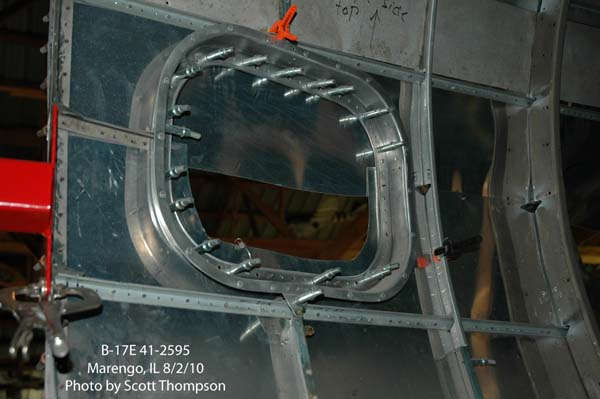
|
September 2010
This is the right forward window in the nose with the new window frame structure clecoed into postion. (Photo by Scott Thompson)
|
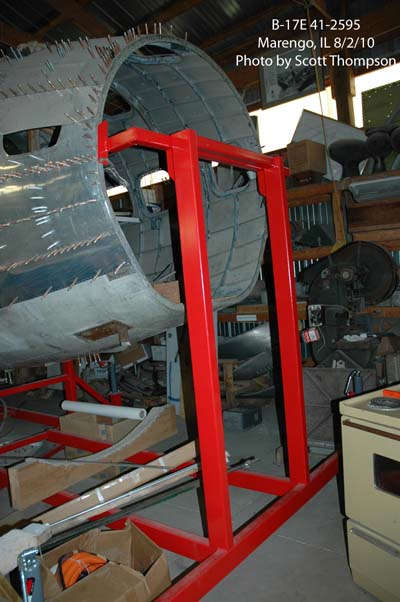
|
September 2010
Details of the fuselage jig and how it is attached to hold the sections immobile as they are fitted back together. The fuselage keel was replaced and forms the basis for allowing the nose to be reattached. Two important longerons located at the 10 and 2 o'clock position, have also been either replaced or slated for repair. (Photo by Scott Thompson)
|
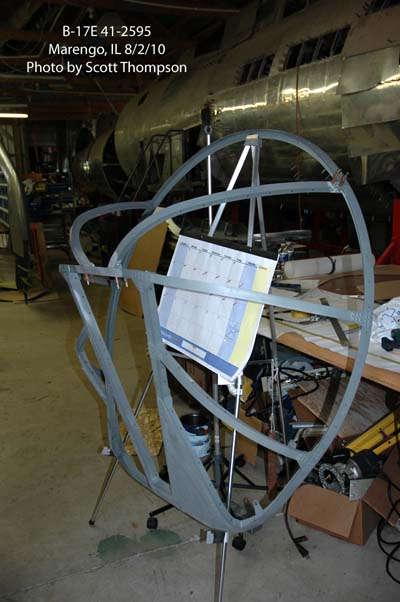
|
September 2010
The framed B-17E nose piece came to the Desert Rat project coated in thick orange paint; no one is quite sure why. However, it is now being rebuilt for installation. (Photo by Scott Thompson)
|
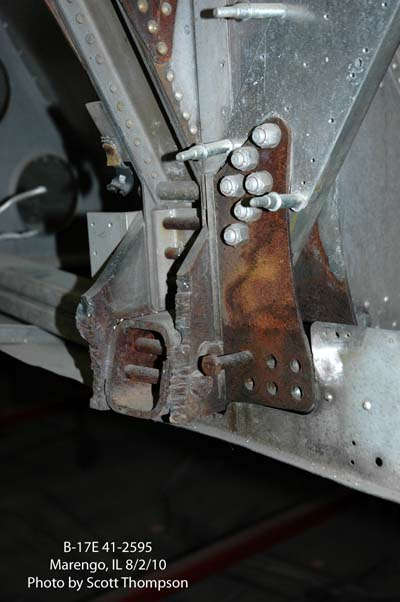
|
September 2010
Interesting take on the forward wing attachement fitting on the right side of the fuselage. The wings were cut off with a welding torch, damaging but not destroying the fitting. Parts can be salvaged and worked into the restoration. (Photo by Scott Thompson)
|
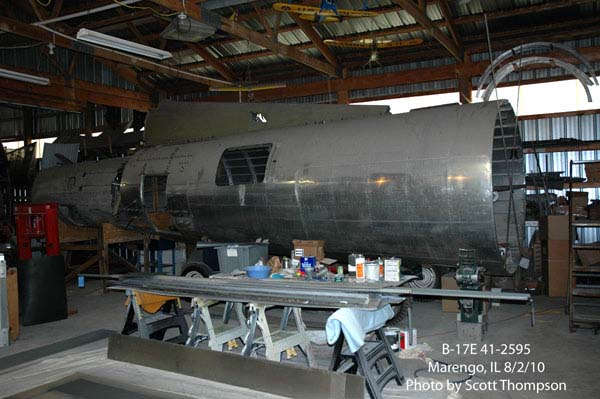
|
September 2010
The aft fuselage section is largely structurally complete. Mike and his crew replaced the large cargo hatch in the left waist area several years ago. Now the section is awaiting being rejoined to the forward fuselage section before wiring and controls can be installed. (Photo by Scott Thompson)
|
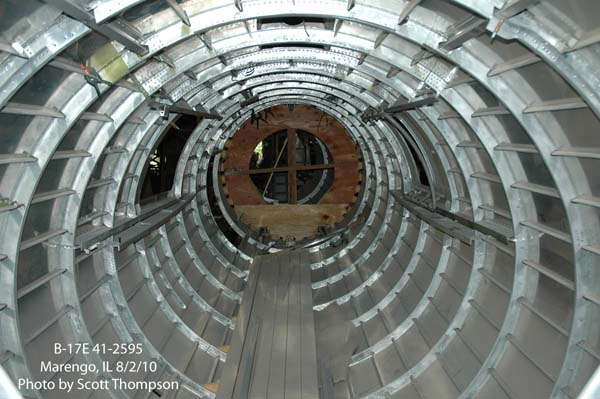
|
September 2010
The interior of the aft fuselage shows the extensive structural work that was required to rebuild the section. Still a long way to go but further work on this section will await the joining of the fuselage. (Photo by Scott Thompson)
|
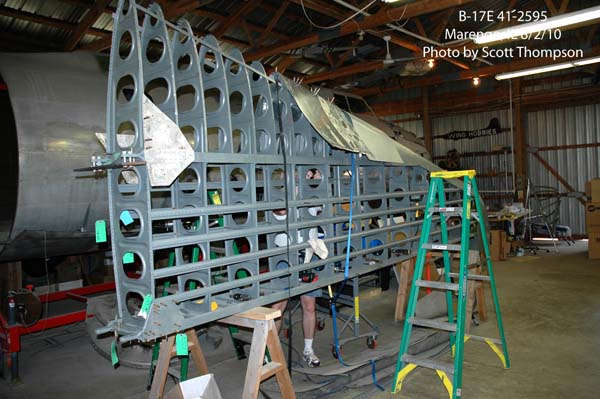
|
September 2010
On of the horizontal stabilizers being rebuilt. Much of the underlying structure was usable but the skins are being replaced. This part took a trip to the Thunder Over Michigan show a few days after this photo was taken. (Photo by Scott Thompson)
|






































